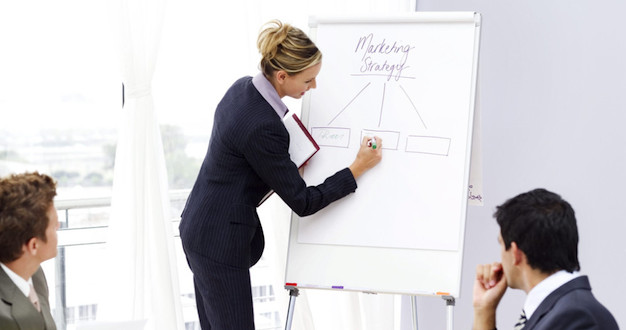The art of the flipchart – 10 tips on how to use a flipchart
By Morag Barrett on July 8, 2014
Posted by Morag Barrett | July 8, 2014The art of the flipchart – 10 tips on how to use a flipchartEver wondered how they do it? You are attending a presentation or training class and the presenter stops and draws this complicated diagram on the flip-chart without missing a beat. Perfectly proportioned, elements clearly labeled. If you are wanting to know the art of the flipchart, here are 10 tips on how to use a flipchart with ease.Do not talk and write at the same time. As soon as you turn your back to the audience your voice will be lost. Plus your audience will be trying to see what you are writing and struggling to link your words to the visual cue they cant see. Draw, turn and then explain.If you are right handed try to set the flip-chart up so that you can stand to its left. This way you can reach across and write without blocking the board. (Do the opposite if you are left handed)Use block capitals – these will be more legible to your audience. If necessary draw very faint pencil lines to help you keep your lines straightWrite keywords / short bullets. As with any visual aid it should act as a memory jogger, not a full script. Try using alternative colors for each line of text.Be creative. Draw shapes (triangles, stars, arrows, dashes) for the bullet point in one color and the text in anotherAlways aim to hang the flip-charts around the room if at all possible. NEVER EVER tear the chart off and screw it up. It sends a message to the audience that the input they have just provided, or your content, is not worth keeping. Hanging the charts around the room reinforces how much has been shared and learnt. Plus you can link back to the points later on if appropriate.Drawing the diagram. Sketch it out with very light pencil beforehand. Trust me, up close you will be able to see it. your audience will not.Write memory joggers on the back of the prior sheet. If you are having to fold the used sheets over the flip-chart easel you can write notes on the back of one page that will help you with the page on display. You will be able to glance at it by stepping alongside the stand and it will not be obvious to your audience.Use post its or tabs to mark important pages so that you can more quickly and easily flip back and forwards as required.Be prepared to lose the ability to spell. Its a well known phenomenon that when you are standing up close to a flip-chart word-blindness can and does occur…and not just with the difficult words!There, 10 practical tips on how to use a flipchart. What would you add to this list?Related ArticlesTags »communicationfear of public speakingPresentation Skills Share
